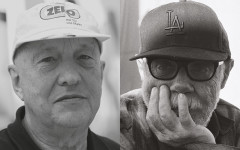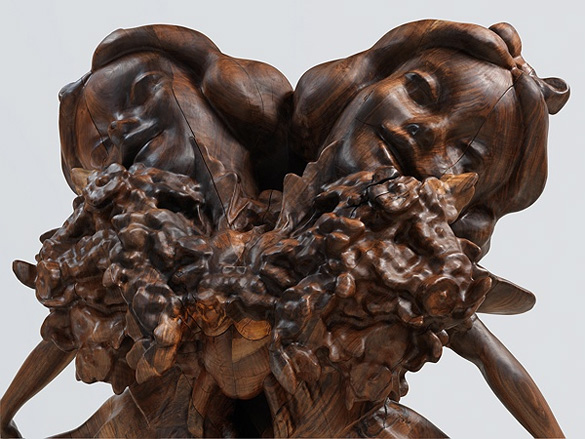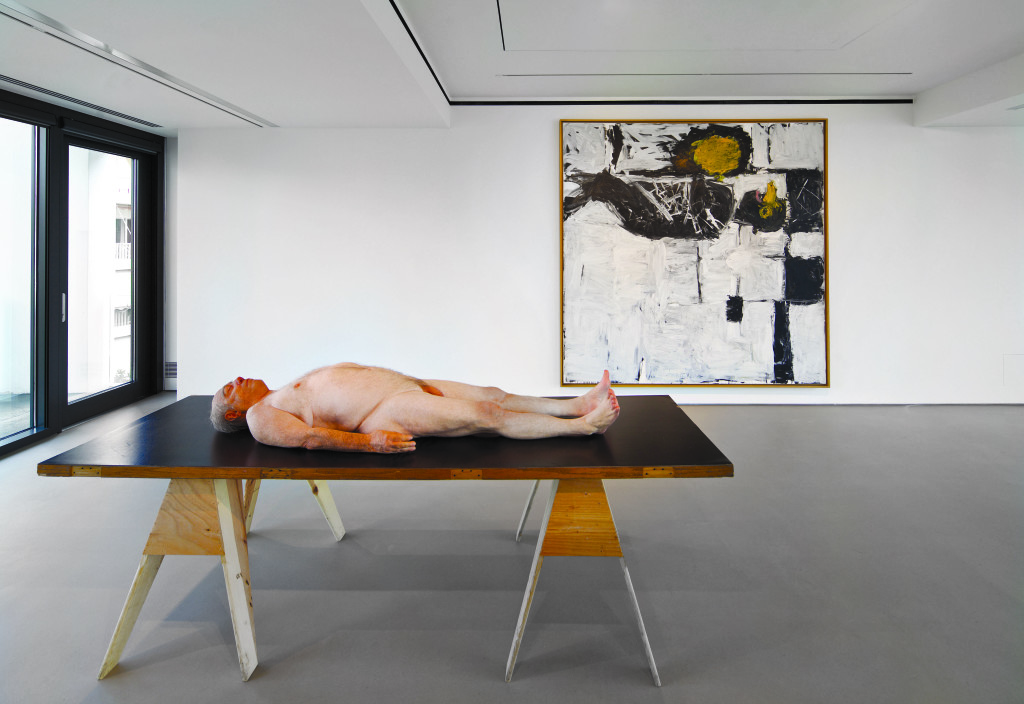Georg Baselitz & Paul McCarthy: George Economou Collection
by Kostas Prapoglou
by Kostas Prapoglou
From a first reading, the work of American artist Paul McCarthy (b.1945) and that of German artist Georg Baselitz (b.1938) might seem quite far apart. But this is not quite the case. Inbetween, the exhibition presented by the George Economou Collection at its impressive private gallery space in Athens, Greece, focuses on these artists’ inter-personal trajectories. Before entering the gallery, the viewer is encountered with Baselitz’s gigantic bronze BDM Gruppe (2012), which prepares viewers for what follows indoors. Spanning the gallery’s three floors and featuring five pieces by Baselitz and four by McCarthy, all are displayed in constant dialogue. The works on view survey the impact of personal change through socio-economic and cultural constraints.

The biographical information of both artists helps to position the relation of their work. McCarthy left the secluded Mormon community of Salt Lake City in Utah, where he was born, to study art in San Francisco in the late 1960s. Around ten years earlier, Baselitz had already moved from East to West Germany. Both artists went through radical changes in the early stages of their career seeking better means of identifying with and interpreting their contemporary society. McCarthy escaped from the conservative environment of the Mormon Church and Baselitz fled from the communist part of Germany.
With childhood memories and experiences strongly registered in their output, both men evoke aspects of their early life events in their artistic lexicon. McCarthy’s performative practice (both live and video—not included in this exhibition) encompasses violent and carnal outbursts, but here has gradually shifted to kinetic (Alpine Man, 1992) and static sculptures (White Snow, Flower Girl, 2012–13) as well as works on canvas (SC, ECK, 2014), works that have been previously exhibited at Hauser & Wirth London in 2014. With painting as his main artistic expression since the 1960s (M.M.M. in G and A, 1961–66 and P.D.Stengel, 1963), Baselitz has reinvented himself through the richness of his palette and the expressionist depiction of his narrative, which has never stopped embracing the human hypostasis.
Of course, McCarthy’s body of work demonstrates a more aggressive stance towards the rejection of the establishment, the liberation from the suppressing effects of an isolated and deeply religious society. The sexual commentary permeating his work is suggestive of personal restrains and perhaps an indirect remark on the controversial practice of polygamy, openly supported by the Mormon Church until 1890 and forbidden ever since, despite the numerous attempts by polygamists to legalize it. McCarthy is continuously testing the sexual and emotional limits of the viewer, while expanding at the same time the boundaries of what is and is not socially acceptable. Previous international shows of his have clearly demonstrated the attempt to provoke and challenge the viewer, most notably in a major survey on his latest work, presented across all Hauser & Wirth venues in London in November 2011 (The King, The Island, The Train, The House, The Ship). There, the combination of political figures, pop culture and the grotesque nature of sex and death generated a powerful show that has since influences the context of his work.

Baselitz’s approach to the pathos of the body and the oppressed sexual impulses are expressed through the early male heroic-appearing, yet disjoined and mutilated, figures of the 1960s (such as Ökonomie, 1965 on display in the present show) and a bit later on, when he began presenting these images upside down. A great rendering of this period was the 2014 British Museum exhibition (Germany divided: Baselitz and his generation from the Duerckheim Collection), where, among other key post-war artists, Baselitz participated with eleven of his Heroes series and other iconic works of the late 1960s.
The questioning of identity, filtered through existential realization, sooner or later occurs in the work of both men. Adler im Bett (Eagle in Bed) (1982) and Hembel (2004) are two good examples of Baselitz’s approach currently on view. In the work of 1982, the corpse of a German eagle is placed horizontally—or more specifically, upside down—whereas in the second work we sense the sinister presence of an inverted skull, a memento mori since ancient times. Outdoors, the oversized sturdy shadows of three souls, BDM Gruppe (2012) mutely overlook the viewer.
McCarthy confronts this sense of mortality in a more forceful way, taking it up on a personal level. He produces his own entire body in the form of a sophisticated hyper-realistic work, using silicone, fiberglass, and natural hair. In Horizontal (2012), we look at the artist himself, lying dead on a table and stripped off his clothes as if in a morgue. He does not mind starring at his own dead body no more than he minds challenging the viewer with the same distressing image.This effigy along with other similar works (That Girl, 2012-2013) were part of Life Cast, another iconic exhibition held at Hauser & Wirth’s 69th Street location in New York back in 2013. Although Inbetween demonstrates just a tiny portion of Baselitz’s and McCarthy’s body of work, it noticeably focuses on parallel orbits and paths of life with experiences that constituted the key factors for thought-provoking and prominent artistic statements or, as Freud and Lacan would probably put it, the impulse for a process of sublimation. Embarking from traumatic childhood experiences both men succeeded in turning their suppressed past into thought-provoking works of art, however following different practices and adapting a diverse visual language.

The Economou Collection show—which is nevertheless very carefully curated— principally focuses on parallel biographical references, but sadly avoids to go beyond the surface and further expand on aspects of analytical discourse involving the artists’ work. Death, sex, and social repression are key life elements that most artists tend to challenge at some point during their career. It is certainly interesting to observe the trajectories of two prominent artists from the same generation, as they emerge from two divergent geopolitical environs and how their practices respond to socio-economic change decade by decade. Undoubtedly, Baselitz’s oeuvre is imbued by a tumultuous, darker esotericism leading towards abstract domains; McCarthy’s work demonstrates a continuous aggression that changes shapes and energy flow but essentially remaining the same.
The two artists are fascinating examples of how two men developed their own defence mechanism against societal dysfunctions resulting in the emergence of the artistic practice that consolidates the ataraxy and the equilibrium of the psyche. The Economou Collection exhibition is an elision of the important work of two artists, the quintessence of an unseen artistic framework, known to the trained but missed by the rest.
Inbetween at the George Economou Collection in Athens runs through October 5, 2015.